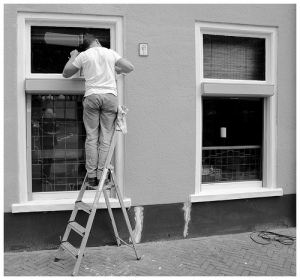A post written for the AthletesFirst blog project that I’ve been part of for the last couple of years:
Ok, it’s a day late, but I value the writing and sharing that goes on through #BADD2014 and wanted to contribute my thoughts. Plus, I’m about a year and a half overdue for a post here on AthletesFirst.
In thinking about ‘disablism’, I found myself mulling over again how I faced disablism in sports. After all, I had the opportunity to represent Canada in Paralympic and non-disabled sport so surely I had plenty of opportunities to develop as an athlete, and I did. I consider myself lucky to have had extremely supportive and encouraging parents and a number of coaches who found opportunities for me to participate, but it certainly wasn’t always easy. My physical impairments aren’t immediately obvious to most people, though occasionally someone will ask or comment on something I do or why my hands shake so much. The visibility and recognition, or lack thereof, of my disability was a blessing and a curse when it came to sports as a young person. Being not quite visible, I didn’t face the initial barriers to entry that many young disabled athletes face when trying to participate in sports. The protests of “we don’t know how to coach a disabled athlete” and “we don’t have the facilities to accommodate your needs” never arose, so getting in was easy.
I don’t know how many of my coaches actually knew about my impairments, I certainly wasn’t forthcoming about them at the time, but it must have been clear that my motor skills weren’t developing at the same rate as my peers. I know it was obvious to me as I can remember how frustrating it was that everyone seemed to be able to learn how to perform sport skills quicker and more precisely than I ever could. As a sport obsessed young person who wanted nothing more than to be a good athlete, this was difficult to cope with emotionally. I can remember many an emotional breakdown where my mom or dad would comfort me and remind me to be patient with my body and acknowledge the effort I was putting in after I became frustrated with being less capable. But I always returned and I learned to adapt. I found that coaches liked athletes who gave 100% effort all the time, that most kids didn’t want to play defence in team sports and I could make up for some of my physical deficits by knowing the sport and anticipating where I needed to be or what I needed to do. I used these adaptations to carve out a niche role for myself so that I had the opportunity to play more often. I was allowed to play hockey with kids a year younger than me and I mostly played in ‘House’ leagues where participation was the focus. I also began to realise that team sports might not afford me as many opportunities to play as individual sports. I’m thankful that I had the support to continue to play sports because it enabled me to develop adaptive skills that were highly valuable within and beyond the sports arena. Sports were a fertile ground for my development because I had a manageable amount of struggle, balanced with opportunity and strong support.
The reality is not the same for most disabled young people wanting to participate in sport. It is tough to get in the game to start. If kids don’t have a chance to play they won’t develop the physical capabilities and more importantly the joy and love of play through sport. The Canadian Long Term Athlete Development Model holds as the primary goal – ‘Active for Life’. In my mind, this is an admirable goal, but it is very difficult to achieve if there aren’t opportunities for children of all abilities to participate and develop early. Too often children’s sport becomes about competition and raising the best, most capable early developers to the top. Those who don’t have the same abilities or experiences struggle to find their place and too often drop out. There are sport organisations that take these type of open approaches, but they are in the minority. I also think there needs to be a more active and creative discussion about how competitive sport can be restructured to facilitate the participation of people with diverse abilities while still enabling meaningful sport development for those who are developing quicker. I think the “All-Comers Track Meet” is a good example of how this can work. People compete in sections based on time rather than age or gender. People race to win their section and results are posted, but the meets are more informal get togethers and the focus tends to be on the personal performance. I’m not sure how this looks for team sports, but I’m sure it could be done, though there may be some need to account for age development. The visibility of your impairments shouldn’t be the determinant of your ability to play. The exclusion that comes with competitive sport is as damaging for its emotional effects on self-perception of ability as it is on the physical development. When I was picked last, or short shifted I came to see myself as a bad athlete, when actually I was developing to be a very good athlete within my physical limitations. I hope as our sport system continues to develop it will be render disablism less visible in the sports arena.
Thank you to Mom, Dad, Bob & Marilyn Dailey, Mr. Geiger & Mr. Abrahamson, Doug Lindores, Brent Clark and David Howe for seeing my ability, giving me the chance to play and supporting my development.





Reasons for coding – a response
My comments and response to this post from Jim Cash: Scratch vs. Swift Playgrounds
In particular, this list:
‘ Why do you want kids to learn to code?‘ by @cashjim on “Scratch vs. Swift Playgrounds”
I’m right with you on Scratch as a great place to start with programming for children. I work with slightly older students and have been using p5.js (Processing) as an intro to typed coding languages. I find it works well because syntax is straightforward, it is essentially Javascript using Processing elements and it can be run in a browser with students quickly able to see the results of their code. Much like in Scratch, Logo and some other learning languages, the connection between the concrete representation and the ability to see the change immediately make the language less abstract.
In terms of the list of right/wrong answers, I think some adjustment in phrasing might be helpful. First, the items on the left are specific knowledge that students will need to learn in order to do the items listed on the right. So, they might not be the best motivating factors for learning to code, but they aren’t “wrong” learning goals for coding.
To further support that, if we frame the items on the left in-terms of larger concepts they sound a lot better as reasons for coding. For instance, ‘learning hexadecimal codes’ or ‘learning binary’ (not in your list) could be phrased as “Learning that numbers can be represented in many ways using different bases that have advantages in a variety of contexts.” As a math teacher that is a really good reason to use coding because it provides a way for students to use different number bases in a context where those bases have meaning. We might also combine ‘Use if then statements’ and ‘learn boolean logic’ under “Learn that many problems requiring conditional thinking about the factors involved and possible outcomes.” I would see this as a mental model that is transferable beyond coding and again a great reason for learning through coding. I could go on with the examples. My point being, I think it is important to be careful about trying to separate off the ‘technical’ skills of coding from the broader goals of coding because they are interdependent.
1 Comment
Posted in Uncategorized
Tagged comment, knowledge, programming, skills